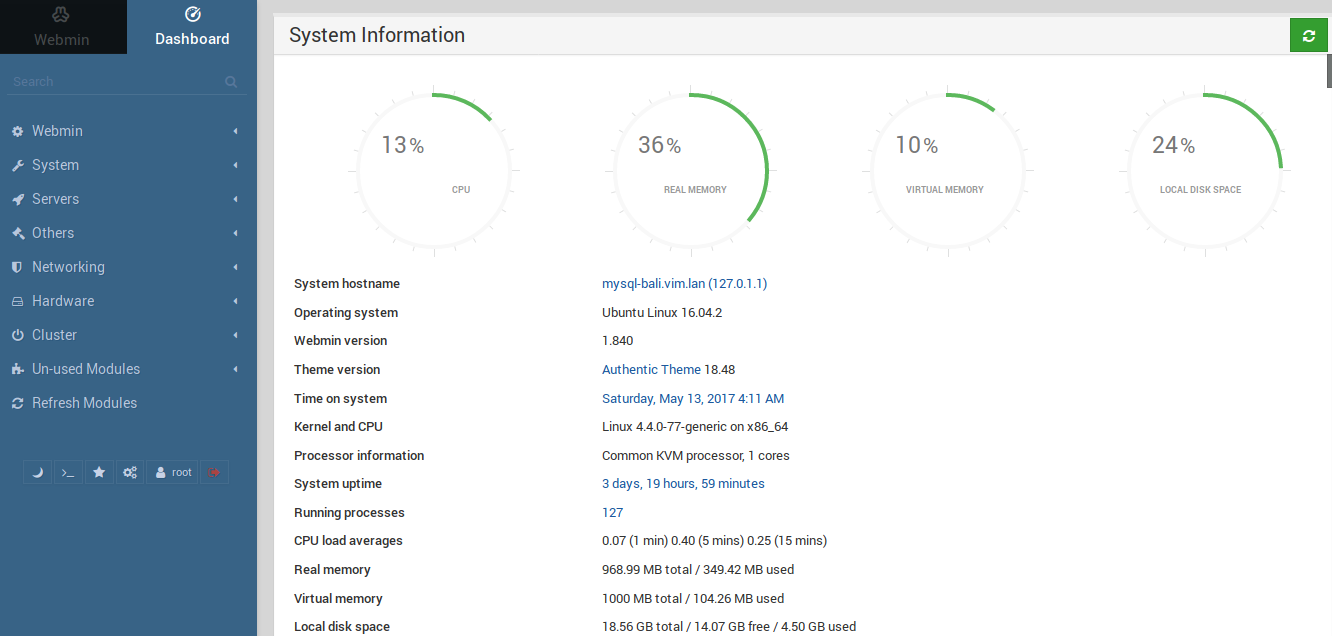
- #Ubuntu install webmin how to
- #Ubuntu install webmin update
- #Ubuntu install webmin software
- #Ubuntu install webmin free
We are now going to edit the file INTERFACES. So next time it's easier to connect.Ī new window will open. Note: One way to edit a file is using your local Ubuntu Desktop and navigate to > PLACES menu > CONNECT TO SERVER > TERMINAL can be found under Ubuntu desktop panel menu > APPLICATIONS > TERMINAL It will be use to access the remote Ubuntu Server via SSH.Ĭonnect to your remote Ubuntu server via SSH on your home computer.

One local home computer with Ubuntu 8.04 LTS Desktop Edition 32bit version. Access to “Universe” and “Multiverse” Ubuntu repositories. Such as most VPS, dedicated or your own server. Once Virtualmin is installed the swap disk can be reduce to 512MB. At least 2GB (2048MB) of swap disk (Linux virtual memory). If unsure you better install with more RAM then needed. It will be install by the below installation script. Ubuntu is the most popular Open Source Linux distro.
#Ubuntu install webmin free
Ubuntu Server is a free open source operating system very performant to host websites. But in this how-to we will be using the 32 bits version.

A freshly installed Ubuntu 8.04 LTS Server Edition 32bit version. $0 for the above softwares because we are going to use only Open Source softwares. There're lot of steps below but that's easy. An installation script will do most of the hard work for you.
#Ubuntu install webmin how to
You are now free to further explore what Webmin has to offer on your Ubuntu system.This how to handbook is for absolute beginners. Your will be presented with Webmin main dashboard with your Ubuntu data at: System Information Ubuntu System Information Stats History Ubuntu System Usage System Activity Ubuntu System Activity Use your Ubuntu sudoer/root user credentials to log in. You will be presented with the following Login screen. Webmin Security WarningĬlick on Accept the Risk and Continue. To access Webmin, adhere to the syntax: Server IP or Domain Name]:10000/Ĭlick the Advanced tab. If you have a firewall enabled on your Ubuntu system, you will need to grant Webmin access through it, which uses TCP port 10000. Once installed, you can check on Webmin’s installed version: $ dpkg -l | grep webminĬheck on Webmin’s running status: $ sudo systemctl status webmin Webmin installation process might take some time to complete, therefore, be patient and restrain from interrupting the installation process. Proceed to its installation by executing the following command: $ sudo apt install webmin -y Now your Ubuntu system is ready for the installation of the Webmin server management software. $ sudo chmod 644 /etc/apt//ubuntu-webmin.gpgįor this Webmin repository to be included on our Ubuntu system, we need to run another system update. $ sudo wget -q -O- | sudo gpg -no-default-keyring -keyring gnupg-ring:/etc/apt//ubuntu-webmin.gpg -import Next, the following command adds Webmin’s associated GPG key to your Ubuntu system and makes the key file readable. $ sudo nano /etc/apt/sources.listĪdd the Webmin repository at the bottom of the file.
#Ubuntu install webmin update
Next, add and enable the Webmin repository to sources.list file, so that it will be easier to update it with a normal system update command. $ sudo apt install software-properties-common apt-transport-https

#Ubuntu install webmin software
Next, make sure the following software packages are installed on your Ubuntu system for effective management of software repositories. Your Ubuntu system should be up-to-date to be optimized for the best performance of any software post-installation. Prerequisiteīe a sudoer/root user on the Ubuntu system you intend to install and configure Webmin database administration software. This article introduces Webmin as a reputable web-based admin tool, that makes the life of a Linux administrator much easier as it lessens the user footprints needed to effectively manage a targeted Linux system/server. However, as time goes by, you will start to feel the urge/need for a flexible and less time-consuming approach to managing your Linux server. Server management is an exciting concept for all Linux users whether they are beginners, still learning their ways around the Linux OS architecture, or expert users that can manage and administer different Linux operating system distributions.


 0 kommentar(er)
0 kommentar(er)
